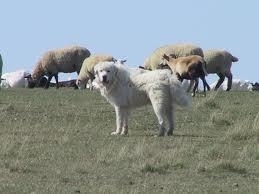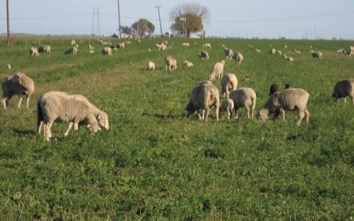‘Sheeping off' or grazing alfalfa fields in the fall and winter, when alfalfa fields are dormant and not growing very fast is frequently of benefit to both alfalfa growers and sheep producers. The bulk of California's lambs are born in the fall and early winter when winter grasses are just beginning to grow from seasonal rains. Grazing alfalfa at this time of year accommodates the lambing operation by providing high quality feed at a time when forage is usually scarce.
However, there are some risks to consider!
Sheep producers commonly establish enclosed paddocks on alfalfa fields with temporary fencing. Sheep are moved to new areas of the field, often daily, to prevent overgrazing, soil compaction (especially if it's wet), and stand loss. Sometimes bedding down also causes damage to hay fields if the sheep are in an area for too long. Water is always provided for the animals (and the dogs are well taken care of and fed too!).
Alfalfa growers also benefit from sheep grazing in their fields during wintertime when the alfalfa is dormant. Sheep feed on winter weeds, helping to control them in both seedling as well as established alfalfa stands that may negate the need for an herbicide treatment. Sheep grazing also reduces the alfalfa vegetation that will commonly die back during the winter, producing cleaner hay the following spring. In addition, sheep help control weevil insect pests by feeding on older alfalfa stems, where the weevils lay eggs. This practice may help reduce weevil pressure and feeding damage to the first alfalfa cutting when weevils are actively feeding, a positive benefit, especially for organic growers.
Watch out for Bloat!
The correct timing of alfalfa grazing is especially important for sheep producers since incorrect timing can result in a potentially lethal condition in sheep called bloat. Bloat occurs when a ruminant, such as sheep, consumes too much fresh, lush alfalfa (or clovers or lush small grains) with a high concentration of leaf proteins called saponins. When saponins are digested in the rumen, they create a stable foam that prevents the sheep from burping up rumen gases that are produced from digestion in their rumen. Grazing too early in the fall or too late in the spring when the alfalfa is lush and actively growing increases the risk of bloat, which is another reason why alfalfa grazing is done during the winter months. Sheep that develop frothy bloat have a distended abdomen, discomfort and bellowing and are at risk for sudden death. Make sure the animals don't enter fields very hungry, and utilize 'bloat-guard' types of products, and watch the animals carefully to prevent death. Discussion of management of alfalfa grazing by Cangiano et al., 2008 is quite helpful.
Economic benefits & Trade-offs
Studies in California have documented economic benefits for both sheep producers and alfalfa growers. Sheep producers benefit from high quality feed during wintertime. Alfalfa growers benefit from weed and weevil control, as well as cleaner hay that can result in higher quality forage compared to non-grazed alfalfa stands.
There is some risk to hay growers in that excessive grazing pressure, excessive hoof compaction of soils, or bad timing reduces regrowth, but many times, grazing does not detract from the hay yield potential the following year, and in fact can reduce weed growth and insect presence.
When you come upon an alfalfa field full of sheep, know that they're there for a purpose, providing feed for sheep and weevil and weed control for the alfalfa, in an environmentally sound manner. And, see if you can get in that game of ‘I Spy' and find those Great Pyrenees dogs guarding the flock from coyotes and other predators. But, don't try to make friends with them, as they have a job to do and need to focus on protecting their sheep.

Additional Reading:
Bell, C.E. and J.N. Guerrero. 1997. Sheep grazing effectively controls weeds in seedling alfalfa. California Agriculture 51(2):19-23. http://calag.ucanr.edu/archive/?article=ca.v051n02p19
Cangiano, C., A.R. Castillo, J.N. Guerrero and D.H. Putnam. 2008. Alfalfa Grazing Management. IN Irrigated Alfalfa Management for Meditereanean and Desert Zones. UC Division of Agriculture and Natural Resources Publication 8304. https://alfalfa.ucdavis.edu/IrrigatedAlfalfa/pdfs/UCAlfalfa8304GrazingMgmt_free.pdf
Doran, M.P., L. Hazeltine, R.F. Long and D.H. Putnam. 2010. Strategic grazing of alfalfa by sheep in California's Central Valley. Technical Report. http://cesolano.ucanr.edu/files/63758.pdf
Pelton, R.E., V.L. Marble, W.E. Wildman and G. Peterson. 1988. Fall grazing by sheep on alfalfa. California Agriculture 42(5): 4-5. http://calag.ucanr.edu/archive/?article=ca.v042n05p4
Natwick E.T, J.N. Guerrero, M.I. Lopez, and A.R. dos Santos. 2003. Lamb grazing and Egyptian alfalfa weevil control. California Alfalfa and Forage Symposium, http://alfalfa.ucdavis.edu/+symposium/proceedings/2003/03-113.pdf
